Pendergast T., Pendergast S. St. James Encyclopedia of Popular Culture. Volume 1: A-D
Подождите немного. Документ загружается.


CHILD STARSENCYCLOPEDIA OF POPULAR CULTURE
499
film, television, and music. Popular culture will ever worship at the
Fountain of Youth.
From the early days of vaudeville in the nineteenth century, child
actors have held their own against adult stars. Adored by fans, many
became household names across America. In the first decade of the
twentieth century, during the infancy of motion pictures, film direc-
tors hoped to lure the top tykes from the stage onto the screen, but
most stage parents refused, feeling that movies were beneath them
and their talented children. Everything changed when a curly haired,
sweet-faced sixteen-year-old, who had been a big Broadway star as
Baby Gladys, fell on hard times and reluctantly auditioned for movie
director D. W. Griffith. Griffith hired the former Baby Gladys on the
spot, renamed her Mary Pickford, and made her into ‘‘America’s
Sweetheart.’’ She became America’s first movie star. As noted in
Baseline’s Encyclopedia of Film, Mary Pickford was, ‘‘if popularity
were all, the greatest star there has ever been.... Little Mary became
the industry’s chief focus and biggest asset, as well as the draw of
draws—bigger, even, than Chaplin.’’
The success of Mary Pickford in many ways paralleled the
ascendancy of movies themselves. As audiences embraced the young
star, they embraced the medium, and movies grew into a national
obsession. Along with Pickford, Charlie Chaplin, himself a former
child star in British vaudeville, became one of the motion picture
industry’s success stories. A huge star by the late teens, Chaplin made
the films that America wanted to see. When he discovered a young
boy performing in vaudeville who reminded him of himself as a child,
Chaplin created a film for them both to star in. Little Jackie Coogan’s
endearing performance in The Kid made the six-year-old a household
name and launched Hollywood’s Child Star Era.
During the 1920s, studios churned out silent films at an amazing
rate. Westerns, action pictures, murder mysteries, and romances all
drew audiences to the theatres. After The Kid, so did movies starring
children, including the immensely popular Our Gang series. Movie
studios sent out continual casting calls in search of clever and cute
kids, and parents from all over America began to flock to Hollywood
in search of fame and fortune for their offspring. When Jackie Coogan
was awarded a million-dollar movie contract in 1923, the race to find
the next child star was on. As Diana Serra Carey, a former child star
who became very famous during the 1920s and 1930s as Baby Peggy,
has written: ‘‘Although the child star business was a very new line to
be in, it opened up a wide choice of jobs for many otherwise unskilled
workers, and it grew with remarkable speed. Speed was, in fact, the
name of the game. Parents, agents, producers, business managers, and
a host of lesser hangers-on were all engaged in a desperate race to
keep ahead of their meal ticket’s inexorable march from cuddly infant
to graceless adolescent.’’ Soon Hollywood was filled with a plethora
of people pushing their youthful products.
In 1929, when the stock market crashed and America fell into the
Great Depression, the movie industry faced a crisis: in a time of
severe economic hardship, would Americans part with their hard-
earned money to go to the movies? But sound had just come in, and
America was hooked. For a nickel, audiences could escape the harsh
reality of their daily lives and enter a Hollywood fantasy. Movies
boomed during the Depression, and child stars were a big part of
that boom.
By the early 1930s, children had come to mean big business for
Hollywood. The precocious and versatile Mickey Rooney had been a
consistent money earner since the mid-1920s, as were new stars such
as The Champ’s Jackie Cooper. But nothing would prepare Holly-
wood, or the world, for the success of a curly haired six-year-old
sensation named Shirley Temple.
The daughter of a Santa Monica banker and his star-struck wife,
Shirley Temple was a born performer. At three, the blond-haired,
dimpled cherub was dancing and singing in two-reelers. By six, when
she starred in Stand Up and Cheer, she had become a bona fide movie
star. Baseline’s Encyclopedia of Film notes: ‘‘Her bouncing blond
curls, effervescence and impeccable charm were the basis for a
Depression-era phenomenon. Portraying a doll-like model daughter,
she helped ease the pain of audiences the world over.’’ In 1934, she
received a special Academy Award. A year later, she was earning one
hundred thousand dollars a year. For most of the 1930s, Shirley
Temple was the number one box office star. Twentieth-Century Fox
earned six million dollars a year on her pictures alone.
During the height of the Child Star Era, the major studios all
boasted stables of child actors and schoolrooms in which to teach
them. Among the top stars of the decade were the British Freddie
Bartholomew, number two to Shirley Temple for many years; Deanna
Durbin, the singing star who single-handedly kept Universal Studios
afloat; and the incredibly gifted Judy Garland. But for every juvenile
star, there were hundreds of children playing supporting and extra
roles, hoping to become the next Shirley Temple.
As America emerged from the Depression and faced another
World War, the child stars of the 1930s faced adolescence. Shirley
Temple, Freddie Bartholomew, and Jackie Cooper had become
teenagers, and Hollywood didn’t seem to know what to do with them.
Audiences were not interested in watching their idols grow up on
screen, and most child stars were not re-signed by their studios.
Shirley Temple was literally thrown off the lot that she had grown up
on. But there were always new kids to take the place of the old, and in
the 1940s, Hollywood’s top stars included Roddy McDowall, Marga-
ret O’Brien, Natalie Wood, and Elizabeth Taylor. As their predeces-
sors had done, these child stars buoyed American audiences through
difficult times. And again, when their own difficult times came with
adolescence, American audiences abandoned them. Fortunately, for
many of the child stars of the 1940s, times were changing, and so was
Hollywood. As the studio system and Child Star Era began to crumble
in the late 1940s, these youthful actors and actresses found work in
independent films and in television.
By the early 1950s, audiences were calling for a different kind of
film, and Hollywood was complying. Television became the new
breeding ground for child stars, as youthful actors were called upon to
appear in such popular sitcoms as Leave It to Beaver in the 1950s, My
Three Sons in the 1960s, The Brady Bunch in the 1970s, Diff’rent
Strokes in the 1980s, and Home Improvement in the 1990s. Although
TV audiences were interested in watching the children on their
favorite shows grow up on the air, making the transition from child to
teenager more easily accomplished, because the life of a series was
generally short, youthful TV stars faced the same trouble as their child
movie star predecessors once the show went off the air. They found it
difficult to be taken seriously as adult actors. They also found it
difficult to adjust to a life out of the limelight. As Jackie Cooper once
said: ‘‘One thing I was never prepared for was to be lonely and
frightened in my twenties.’’
The music industry, too, has always had its fair share of child
prodigies. From Mozart to Michael Jackson, audiences have always

CHINA SYNDROME ENCYCLOPEDIA OF POPULAR CULTURE
500
been drawn to youthful genius. But while some young stars such as
Little Stevie Wonder managed to make the transition to adult star-
dom, there are equally as many children who have not made it. And
when the music industry began creating child acts to promote, it soon
found itself facing the same problems as had movies and television.
Would audiences who found child singers cute still buy their records
when they were less-than-talented adults? In too many cases, the
answer was no.
When little Ronnie Howard of The Andy Griffith Show was cast
as a teenager on Happy Days, it was a big step for a child star. When
he became a successful movie director, he was lauded as having
dodged the stigma of child stardom. Others have followed in his
footsteps, most notably Jodie Foster, a two-time Academy Award
winner who is one of Hollywood’s most respected actresses and
directors. And, of course, Shirley Temple went on to have a distin-
guished political career, serving as a United States ambassador. But
for every Ron Howard, Jodie Foster, Roddy McDowall, or Shirley
Temple, there are hundreds of former child stars who have had to face
falling out of the spotlight. For all the former child stars who have
managed to create for themselves a normal adult life, there are far too
many who have fallen into a life of dysfunction or drug use. For
others, such as Rusty Hamer, a child star for nine years on Make Room
for Daddy, or Trent Lehman, who played Butch on Nanny and the
Professor, the transition from child star to adulthood ended in suicide.
In 1938, twenty-four-year-old Jackie Coogan went to court to
sue his mother for his childhood earnings, which were between two
and four million dollars. Married to a rising young starlet named Betty
Grable, Coogan was broke and sought to get what was legally his. By
the end of the trial, his millions were found to be almost all gone, and
the strain of the trial destroyed his marriage. But out of Coogan’s
tragedy came the Coogan Act, a bill which forced the parents of child
actors to put aside at least half of their earnings. That still hasn’t
prevented child stars such as Gary Coleman from having to go to court
to fight for their hard-earned millions, however.
During the 1980s and 1990s, the motion picture industry has
witnessed a resurgence of interest in child stars. River Phoenix and
Ethan Hawke, both teenage actors, managed to make the difficult
transition to adult roles. But Phoenix, although a seemingly mature
young man praised for his formidable talents, found the pressures of a
Hollywood lifestyle too much and died of an accidental drug overdose
in 1993. In the early 1990s, Macaulay Culkin was perhaps the biggest
child star since Shirley Temple. But when audiences lost interest in
the teenager, he stopped working altogether. Soon his parents were
engaged in a battle over custody and money, while the tabloids ran
articles about Culkin’s troubled life.
Despite the object lessons drawn from the lives of so many child
stars, audiences will continue to pay to see juvenile performers even
as the television, movie, and music industries will continue to
promote them. Child stars represent the duel-edged sword that is
American popular culture. Epitomizing the youthful glamour by
which Americans are taught to be seduced, children have entranced
audiences throughout the twentieth century. But on the other side of
glamour and fame are the bitter emptiness of rejection and the harsh
reality of life out of the spotlight. Perhaps former child star Paul
Petersen said it best: ‘‘Fame is a dangerous drug and should be kept
out of the reach of children—and their parents as well.’’
—Victoria Price
F
URTHER READING:
Cary, Diana Serra. Hollywood’s Children: An Inside Account of the
Child Star Era. Dallas, Southern Methodist University, 1997.
Monaco, James, and the editors of Baseline. The Encyclopedia of
Film. New York, Perigee, 1991.
Moore, Dick. Twinkle, Twinkle Little Star: And Don’t Have Sex or
Take the Car. New York, Harper and Row, 1984.
Zierold, Norman J. The Child Stars. New York, Coward-McCann, 1965.
The China Syndrome
Possibly more than any other film, The China Syndrome’s
popularity benefited from a chance occurrence. The China Syndrome
showed many Americans their worst vision of technology gone
wrong, but it proved entirely too close to reality when its release
coincided with a near meltdown at Three Mile Island, Pennsylvania.
In the film, Jane Fonda and Michael Douglas play the television news
team who, while researching the newly perfected nuclear technology,
capture on film an accident resulting in a near meltdown of the power
plant. Fonda and Douglas’s characters find themselves trapped be-
tween the public’s right to know and the industry’s desire to bury the
incident. The nuclear accident depicted by the film became the
platform for ‘‘NIMBY’’ culture, in which expectations of comfort
and a high standard of safety compelled middle-class Americans to
proclaim ‘‘Not in my backyard!’’ Together, these incidents—one
fictional and another all too real—aroused enough concern among
Americans to prohibit nuclear energy from ever becoming a consider-
able source of power for the nation.
—Brian Black
Chinatown
Roman Polanski directed this 1974 classic film portraying the
mystery and intrigue of Raymond Chandler’s fascinating novel. Jack
Nicholson played Jake Gittes, a private detective trapped in the odd
Asian-immigrant culture of the desert West. Hired to investigate the
murder of the chief engineer for the Los Angeles Power and Water
Authority in 1930s California, Gittes finds himself pulled into the
unique political and economic power structure of the arid region:
water politics with all its deceits and double dealings dominates
planning and development.
The film acquired a cult following because of its dark, intriguing
story—seemingly based in another world and era—and the enduring
popularity of Jack Nicholson. Chinatown’s film noir setting places it
in a long line of fine films deriving from the 1940s mysteries of Alfred
Hitchcock. The defining characteristic of such films is uncertainty—
of character and plot. Gittes repeatedly appears as the trapped
character searching in vain for truth; indeed, the viewer searches with
him. In the end, the evil is nearly always exposed. However, typical to
film noir, Chinatown’s conclusion leaves the viewer strangely unsure
if truth actually has emerged victorious.
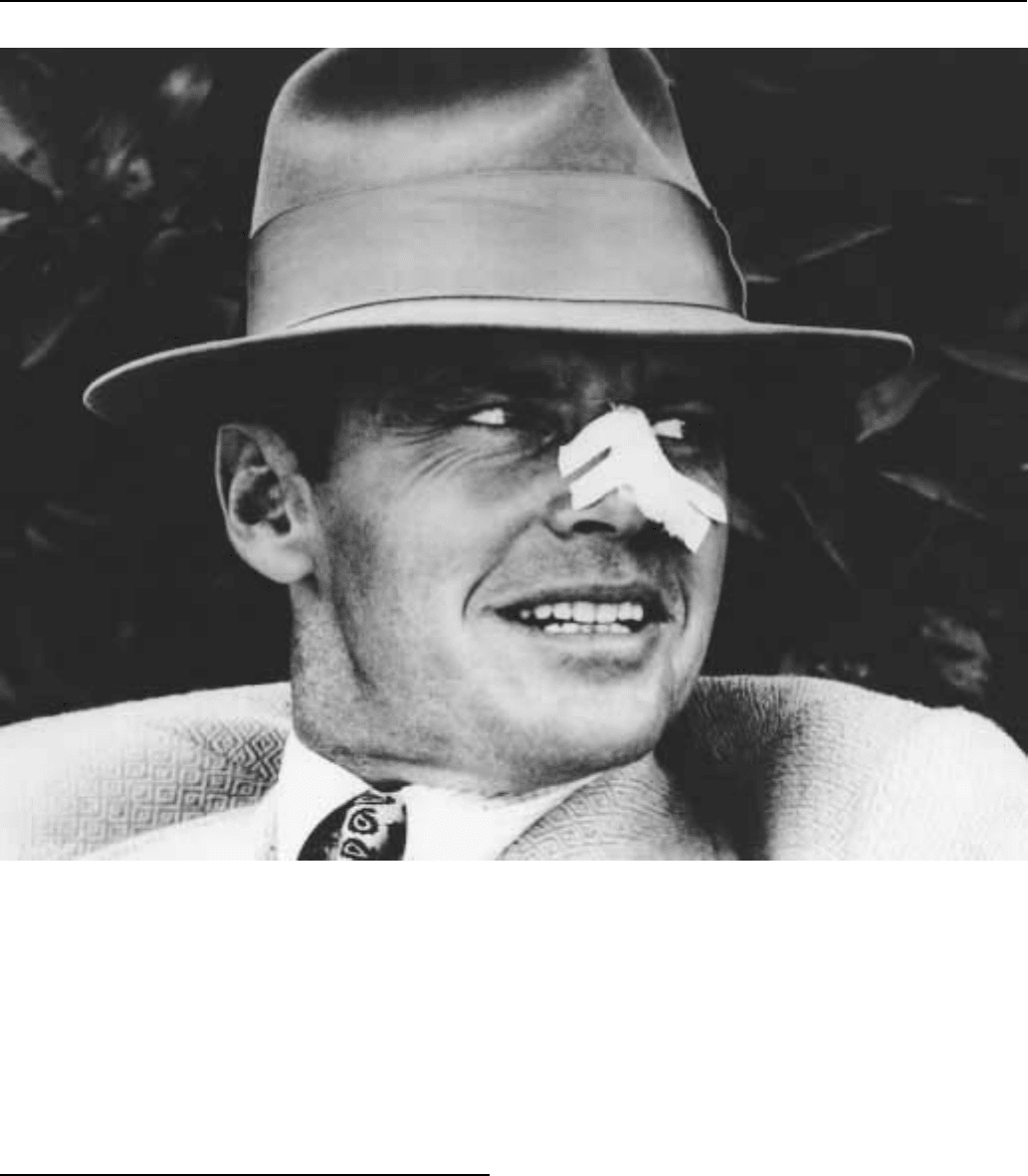
CHIPMUNKSENCYCLOPEDIA OF POPULAR CULTURE
501
Jack Nicholson in a scene from the film Chinatown.
In 1990, Nicholson starred in and directed Chinatown’s sequel,
The Two Jakes, set in 1948 California. Oil has replaced water as the
power source for regional wealth, creating a fine backdrop for another
dark mystery based on adultery and intrigue.
—Brian Black
The Chipmunks
The Chipmunks—Alvin, Simon, and Theodore—were the only
cartoon rodents to sell millions of records and star in their own
television series. The voices of all three chipmunks, as well as the part
of David Seville, were performed by actor/musician Ross Bagdasarian
(1919-1972). As Seville, Bagdasarian had enjoyed a #1 hit with
‘‘Witch Doctor’’ in early 1958; later that year he released ‘‘The
Chipmunk Song’’ (‘‘Christmas Don’t Be Late’’) in time for the
Christmas season, and sold over four million singles in two months.
The Chipmunks, with their high warbling harmonies, churned out a
half dozen records in the late 1950s and early 1960s. All of
Bagdasarian’s records were on the Liberty label, and the chipmunks
were named for three of Liberty’s production executives.
The Chipmunks’ popularity led to a primetime cartoon series
(The Alvin Show) on CBS television during the 1961-62 season. In
1983, Ross Bagdasarian, Jr., revived the act with a second successful
cartoon series, Alvin and the Chipmunks, which aired on NBC from
1983 to 1990, and a new album, Chipmunk Punk.
—David Lonergan
F
URTHER READING:
Brooks, Tim, and Earle Marsh. The Complete Directory to Prime
Time Network TV Shows. 5th edition. New York, Ballantine
Books, 1992.
‘‘Cartoon-O-Rama Presents: The Alvin Show.’’ http://
members.aol.com/PaulEC1/alvin.html. February 1999.
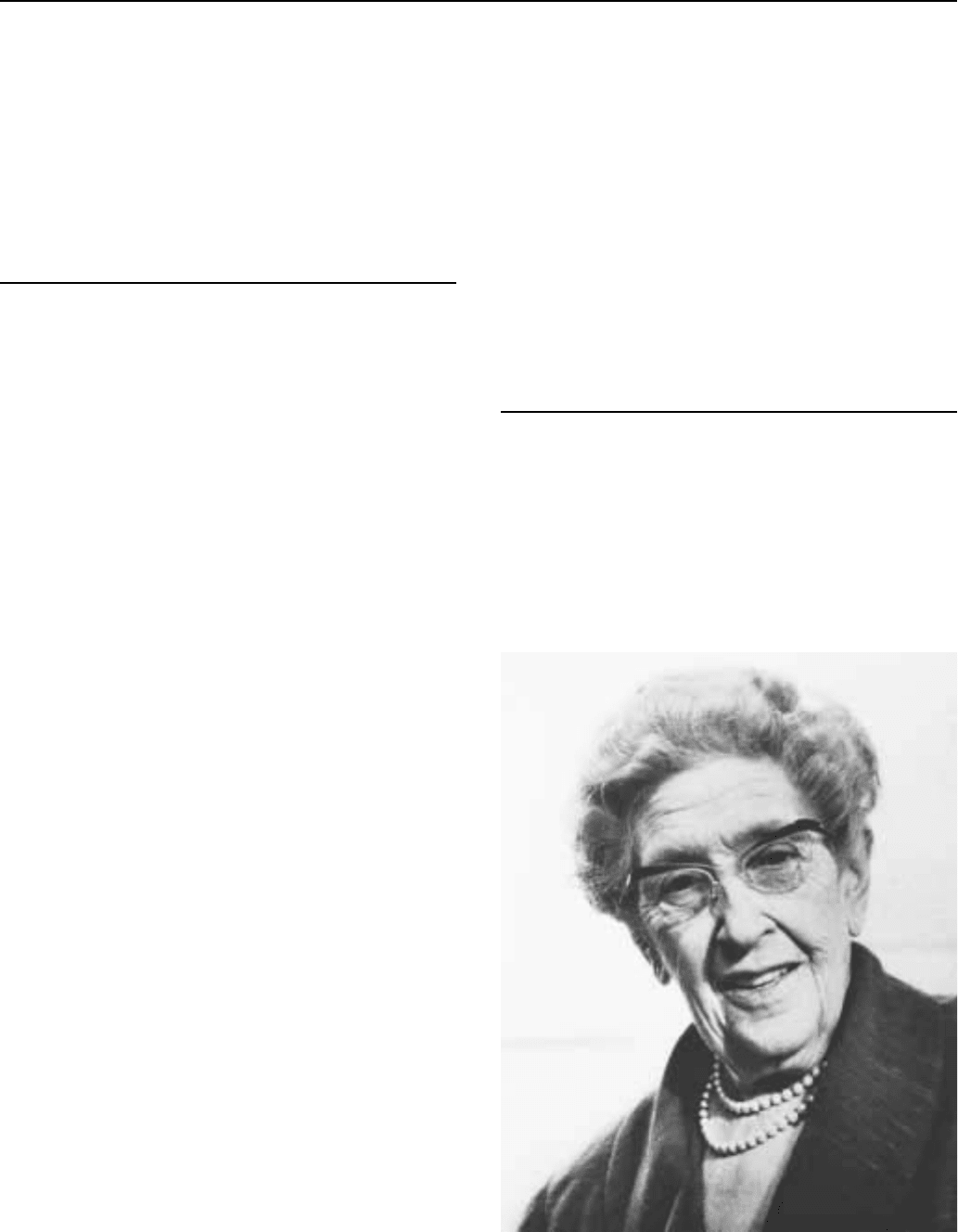
CHOOSE-YOUR-OWN-ENDING BOOKS ENCYCLOPEDIA OF POPULAR CULTURE
502
Whitburn, Joel. The Billboard Book of Top 40 Hits. 6th edition. New
York, Billboard Books, 1996.
Chong, Tommy
See Cheech and Chong
Choose-Your-Own-Ending Books
Thanks to the interactive capabilities of the computer, traditional
styles of linear narrative in storytelling can be altered by means of
hypertext links that allow readers the ability to alter the direction of a
story by making certain decisions at various points, in effect choosing
their own endings. This interactive style was presaged in the 1970s
when several children’s publishers began offering books that invited
readers to custom-design the flow of a story by offering a choice of
different pages to which they could turn. Strictly speaking, ‘‘Choose-
Your-Own-Ending Books’’ refer to several series of children’s books
published by Bantam Books since 1979. Originated by author Edward
Packard, Bantam’s ‘‘Choose-Your-Own-Adventure’’ series num-
bered about 200 titles in the first 20 years of publication, with spinoffs
such as ‘‘Choose Your Own Star Wars Adventure’’ and ‘‘Choose
Your Own Nightmare.’’
The ‘‘Choose Your Own Adventure’’ series has proven to be
immensely popular among its young readers, who unwittingly gave
their blessing to the concept of interactive fiction even before it
became commonplace on computer terminals or CD-ROMs. A 1997
profile of Packard in Contemporary Authors quoted an article he
wrote for School Library Journal in which he stated that ‘‘multiple
plots afford the author the opportunity to depict alternative conse-
quences and realities. Complexity may inhere in breadth rather than in
length.’’ The technique appealed to young readers for whom active
participation in the direction of a narrative was a sign of maturity and
ownership of the text.
The first book Packard wrote in this style, Sugarcane Island, a
story about a trip to the Galapagos Islands, did not excite interest
among publishers so he put it aside for five years. It finally found a
home with Vermont Crossroads Press, an innovative children’s book
publisher, which brought out the book in 1976. The fledgling series
gained national attention when the New York Times Book Review
(April 30, 1978) devoted half a page to a Pocket Books/Archway
edition of Sugarcane Island and to a Lippincott edition of Packard’s
Deadwood City. Reviewer Rex Benedict wrote: ‘‘Dead or alive, you
keep turning pages. You become addicted.’’
Other reviewers, especially in the school library press, felt that
the books were gimmicky and that they prevented children from
developing an appreciation for plot and character development.
An article in the journal Voice for Youth Advocates endorsed the
books for their participatory format, however, noting that ‘‘readers’
choices and the resulting consequences are fertile ground for develop-
ing students’ ability to predict outcomes or for group work on
values clarification.’’
Writers who have contributed to the series and its various
spinoffs have included Richard Brightfield, Christopher Golden,
Laban Carrick Hill, Robert Hirschfeld, Janet Hubbard-Brown, Vince
Lahey, Jay Leibold, Anson Montgomery, R. A. Montgomery, and
Andrea Packard.
—Edward Moran
F
URTHER READING:
Contemporary Authors, New Revision Series, vol. 59. Detroit, Gale
Research, 1998.
Packard, Edward. Cyberspace Warrior. New York, Bantam, 1994.
———. Deadwood City. Philadelphia and New York, J. B. Lippin-
cott, 1978.
———. Fire on Ice. New York, Bantam, 1998.
———. Sugarcane Island. Vermont Crossroads Press, 1976.
Christie, Agatha (1890-1979)
Deemed the creator of the modern detective fiction novel and
nicknamed the Duchess of Death, Agatha Christie continues to be one
of the most popularly read authors since the publication of her first
book, The Mysterious Affair at Styles, in 1920. Since then, more than
100 million copies of her books and stories have been sold.
Born Agatha Miller on September 15, 1890, in Torquay, located
in Devonshire, England, Christie enjoyed a Victorian childhood
where her parents’ dinner parties introduced her to Henry James and
Rudyard Kipling. Formally educated in France and debuting in Cairo,
Agatha Christie

CHRISTMASENCYCLOPEDIA OF POPULAR CULTURE
503
Agatha began writing seriously after she married Archibald Christie
in 1914. She wrote her first novel in 1916 in just two weeks. Several
publishers rejected the manuscript. Almost two years later, John Lane
accepted the book and offered her a contract for five more.
While her creative interests increased, Christie’s relationship
with her husband steadily declined until he left her in 1926 for his
mistress, Nancy Neele. On December 6 of the same year, Christie
disappeared for eleven days. Her car was found abandoned at Newlands
Corner in Yorkshire. Later, employees at the Hydro Hotel in Harrogate
recognized Christie as a guest at the spa resort, where Christie had
identified herself to hotel employees and guests as Teresa Neele from
South Africa. Christie later claimed to have been suffering from
selective amnesia; she never wrote about her disappearance.
Divorcing her first husband in 1928, Christie married Max
Mallowan in 1930 after meeting him during an excursion to Baghdad
in 1929. Accompanying him on archeological excavations, Christie
traveled extensively in the Middle East and also to the United States in
1966 for his lecture series at the Smithsonian Institute. While stateside,
Christie began to write a three-part script based on Dickens’s Bleak
House. She only completed two parts of the project before withdraw-
ing herself from the script. While she enjoyed novel and short story
writing, Christie cared little for scriptwriting and even less for the film
adaptations made from her novels, even though critics praised Charles
Laughton’s and Marlene Dietrich’s performances in Witness for the
Prosecution (1955).
Several national honors arose in accordance with Christie’s
popular fame as a novelist. In 1956, she was named Dame Command-
er of the Order of the British Empire, and in 1971, Christie was
appointed Dame of the British Empire. Despite these accolades,
Christie continued to lead a quiet private life, writing steadily until her
death in 1979.
Though mystery novels as a genre became fashionable in the
nineteenth century, Christie popularized the format so successfully
that mystery writers continue to follow her example. Christie built on
an early modern theme of comedies: a misunderstanding, crime, or
murder occurs in the first act, an investigation follows with an
interpolation of clue detection and character analysis, and the story
concludes with a revelation, usually of mistaken identities, leading to
the capture of the murderer.
During her life, Christie wrote sixty-six novels, more than one
hundred short stories, twenty plays, an autobiography, and other
various books of poetry and nonfiction. Though her play The Mouse-
trap (1952) is the longest running play in London’s West End,
Christie’s most enduring work incorporates the two now-famous
fictional detectives Hercule Poirot and Jane Marple.
A Belgian immigrant living in London, Hercule Poirot embodies
the ideal elements of a modern detective, though Christie clearly
fashioned him after Sir Arthur Conan Doyle’s Sherlock Holmes. Like
Holmes, Poirot studies not only the clues of the crime but also the
characters of the suspects. What distinguishes him from Holmes is
Poirot’s attention to personal appearance. Even while traveling by
train in Murder on the Orient Express, Poirot finds time to set and
style his moustache. Because of his attention to detail, Poirot, in a
time before fingerprint matches and DNA testing, solves mysteries by
using what he terms ‘‘the little gray cells.’’
Miss Marple, an elderly spinster, acts as Poirot’s antithesis
except for her ability to solve mysteries. Marple is a successful
detective because of her unobtrusive and innocuous presence. Few
suspects assume an older woman with a knitting bag can deduce a
motive behind murder. Marple, like Poirot, however, does embody a
particularly memorable trait: she doesn’t trust anyone. In Christie’s
autobiography, the author describes Miss Marple: ‘‘Though a cheer-
ful person she always expected the worst of everyone and everything
and was, with almost frightening accuracy, usually proved right.’’
Both detectives have been made famous in the United States by
the critically acclaimed television series Poirot and Agatha Christie’s
Miss Marple, produced by and aired on the Arts and Entertainment
network, and beginning in 1989, and on the PBS weekly program
Mystery! Although more than sixty-five film and made-for-television
adaptations have been produced from Christie’s novels, none claims
the following these series command. Immortalizing the roles of
Hercule Poirot and Miss Marple, David Suchet and Joan Hickson
have indelibly imprinted images of the detectives in the minds of fans.
Though Agatha Christie died long before the creation of the series,
her legacy of detective fiction will be remembered in the United
States not only in print but on the small screen as well.
—Bethany Blankenship
F
URTHER READING:
Bargainnier, Earl F. The Gentle Art of Murder: The Detective Fiction
of Agatha Christie. Bowling Green, Ohio, Bowling Green Univer-
sity Popular Press, 1980.
Christie, Agatha. An Autobiography. London, William Collins Sons
& Co, 1977.
Gerald, Michael C. The Poisonous Pen of Agatha Christie. Austin,
University of Texas Press, 1993.
Keating, H. R. F. Agatha Christie: First Lady of Crime. London,
Weidenfeld & Nicolson, 1977.
Osborne, Charles. The Life and Crimes of Agatha Christie. London,
Michael O’Mara Books Limited, 1982.
Wagoner, Mary S. Agatha Christie. Boston, Twayne Publishers, 1986.
Christmas
For Americans, the celebration of Christmas is often considered
one of the most important holidays of the year. Because of the diverse
heritages and customs, in addition to Kwanzaa, a tradition begun in
the later part of the twentieth century, the American Christmas
consists of traditions from not only the German, but English, Dutch,
and other Eastern European countries as well. Having religious
significance, Christmas also celebrates the child found in each
individual and the desire for peace. Falling during the same month as
the Jewish observance of Chanukah or Hanukkah (the Feast of Lights)
and the African-American celebration of Kwanzaa, the season of
Christmas serves as a time of celebration, feasting, and a search
for miracles.
While Christmas generally is considered the celebration of
Jesus’s birth, the early Puritans, who settled the New England region,
refused to celebrate the occasion. Disagreeing with the early church
fathers who established the holiday around a pagan celebration for
easy remembrance by the poor, the Puritans considered the obser-
vance secular in nature. Set during the winter solstice when days grow
dark early, Christmas coincides with the Roman holiday of Saturnalia;
the date, December 25, marks the celebration of Dies Natalis Invicti
Solis, or the birth day of the Unconquered Sun by the Romans.
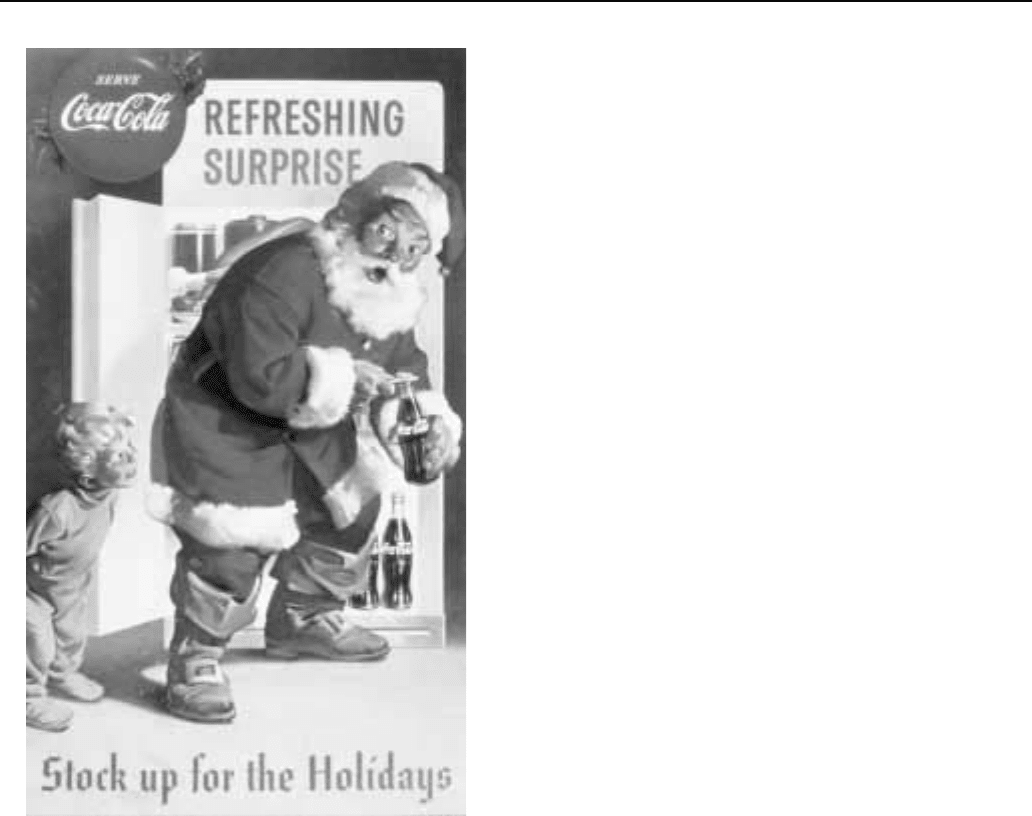
CHRISTMAS ENCYCLOPEDIA OF POPULAR CULTURE
504
An early Coca-Cola advertising poster featuring the company’s
famed Santa Claus.
Puritans believed that these pagan customs, which included no work,
feasting, and gift giving, were inappropriate for the celebration of the
Lord’s birth. While the northern colonists did not observe the day, the
southern colonists celebrated in much the same style as their British
counterparts—with banquets and family visits. Firecrackers or guns
were used to welcome the Christ Child at midnight on Christmas. The
residents of New York (New Amsterdam) celebrated the season in a
similar fashion as their Dutch ancestors had with St. Nicholas Day
(December 6), established to honor the patron saint of children.
Gradually, all observances became centered around the date Decem-
ber 25, with traditions becoming mixed and accepted between differ-
ent ethnic backgrounds.
With these strong ties to religion, Christmas serves an important
role for the Christian faith. The four Sundays before Christmas, or the
season of Advent, prepares the congregation for the arrival of the
Messiah. With wreathes consisting of greenery, four small purple
candles, and one large white candle, church members are reminded of
the four elements of Christianity: peace, hope, joy, and love. This
season of the church year ends with the lighting of the Christ candle
on Christmas morning, signalling the two week period of Christmastide.
Nativity scenes, or creches, adorn altars as a visual reminder of the
true meaning of Christmas.
While attendance at church services and midnight masses seems
commonplace, the first visible sign of the Christmas season appears in
the decoration of the home. Some families decorate the outside of
their home with multi-strings of colored lights, while others focus
their decorations around an evergreen tree of spruce, fir, or cedar. In
the 1960s, a new type of Christmas tree appeared on the market which
allows families to prepare for the season early and leave their
decorations up well into the New Year. Artificial trees have ranged in
style from the silver aluminum trees (1960s) to the imitation spruce
and snow-covered fir. A custom attributed to Martin Luther, the
Christmas tree often appears decorated with lights and ornaments
consisting of family heirlooms—a central theme which had meaning
to the family—or religious symbols. Christmas trees became widely
used after 1841 when Prince Albert placed one for his family’s use at
Windsor Castle. Originally, the Christmas tree was decorated with
candles. With the introduction of electricity, however, strings of small
and large bulbs ranging in color from white to multi-color illumine the
tree. The lighting of the tree dates back to the days when light was
used to dispel the evil found in darkness. Around the base of the tree,
gifts, creches, or large scale displays of Christmas villages represent
some important memory or tradition in the family’s heritage or life.
The Christmas tree is not the only greenery used during the
holiday season. Wreaths of holly, fir, and pine appear on doors and in
windows of homes. Each represents a part of the mystical past or
ancestors’ beliefs. The holly, which the ancients used to protect their
home from witches, also represents the crown of thorns worn by Jesus
at His crucifixion. The evergreen fir and pine represent everlasting
life. Mistletoe, a Druid tradition and hung in sprigs or as a Kissing
Ball, brings the hope of a kiss to the one standing beneath the spray.
The red and white flowering poinsettia, native to Central American
countries and brought to the United States by Dr. Joel Poinsett,
represents the gift of a young Mexican peasant girl to the Christ Child.
Christmas serves as a time when gifts are exchanged between
family and friends. This custom, while attributed to the gifts brought
by the Magi to the Christ Child, can be traced to the earlier celebration
of Saturnalia by the Romans. While the name varies with the country
of origin, the bearer of gifts to children holds a special place in
people’s hearts and comes during the month of December. The most
recognized gift-giver is based on Saint Nicholas, a bishop of Myra in
300 to 400 A. D., and the tradition was brought to America by the
Dutch of New York. Saint Nicholas’ appearance went undefined until
the early 1800s when he appeared in the stories of Washington Irving.
While Irving’s stories would include general references to Saint
Nicholas, Clement Clark Moore would give Americans the image
most commonly accepted. A professor of Divinity, in 1822 Moore
wrote ‘‘A Visit from Saint Nicholas,’’ also known as ‘‘The Night
Before Christmas,’’ as a special gift for his children. A friend, hearing
the poem, had it published anonymously the following year in a local
newspaper. Telling the story of the visit of Saint Nicholas, the poem
centers around a father’s experience on Christmas Eve; the poem
reveals and establishes a new vision of St. Nicholas. St. Nicholas
drives a miniature sleigh pulled by eight reindeer named Dasher,
Dancer, Prancer, Vixen, Comet, Cupid, Donner, and Blitzen. Moore’s
description of Saint Nicholas describes the clothing worn by the man.
‘‘He was dressed all in fur, from his head to his foot, / And his clothes
were all tarnished with ashes and soot; / A bundle of toys he had flung

CHRISTOENCYCLOPEDIA OF POPULAR CULTURE
505
on his back, / And he looked like a peddler just opening his sack.’’ For
the nineteenth century reader, the image of someone dressed like a
peddler with a bag of toys on his back could be easily visualized.
Moore did not end his description here, but gave a physical
description of the man as well. With twinkling eyes and dimples,
Saint Nicholas has a white beard which gives him a grandfatherly
appearance. In addition, Moore added: ‘‘He had a broad face and a
little round belly, / That shook, when he laughed, like a bowlful of
jelly.’’ The jolly gentleman of childhood Christmas fantasy has
become a reality. The description is so vivid that artists began to
feature this portrait of Saint Nicholas in their seasonal drawings. In
1881 Thomas Nast, a cartoonist in New York, would define the
gentleman and give him the characteristics for which he has become
known. Saint Nicholas’s name has changed to the simplified Santa
Claus and has become a lasting part of the Christmas tradition.
Santa Claus and his miraculous gifts have played such a part of
the Christmas celebration that many articles, movies, and songs have
been written about the character. The most famous editorial ‘‘Yes,
Virginia, There Is a Santa Claus,’’ appeared in The Sun in 1897 after a
child wrote asking about Santa’s existence. The response to the
child’s letter is considered a Christmas classic, with many newspa-
pers repeating the editorial on Christmas Day. This same questioning
regarding Santa Claus’ existence is portrayed in the film Miracle on
34th Street (1947), where a young girl learns not only to believe in
what can be seen but also in the unseen. Johnny Marks adds to the
legend of Santa Claus and his reindeer with the song ‘‘Rudolph the
Red-nosed Reindeer’’ (1949), which is performed most notably by
Gene Autry. This song, while using Moore’s names for the reindeer,
adds a new one, Rudolph, to the lexicon of Santa Claus.
The spirit of Santa Claus has not only given the season a defining
symbol, but has also created a season with an emphasis on commer-
cialization. Santa’s bag of toys means money for the merchants.
Christmas items and the mention of shopping for Christmas may
begin as early as the summer, with Christmas tree displays appearing
in retail stores in September and October. Christmas has become so
important to the business world that some specialty stores dedicate
their merchandise to promoting the business of Christmas year-round.
Shopping days are counted, reminders are flashed across the evening
news, and advertisements are placed in newspapers. The images of
Christmas not only bring joy, but also anxiety as people are urged to
shop for the perfect gift and to spend more money.
While the season of Christmas symbolizes various things to
different people, the Christ Child and Santa Claus represent two
differing views of the celebration. The traditions and customs of the
immigrant background have merged and provide the season with
something for everyone. Adding to the celebration the Jewish festival
Chanukah, and the African-American celebration Kwanzaa, the sea-
son of Christmas seems to run throughout the month of December.
With the merging of the sacred and the pagan, magic is revisited and
dreams are fulfilled while money is spent in the never-ending cycle
of giving.
—Linda Ann Martindale
F
URTHER READING:
Barnett, James H. The American Christmas: A Study in National
Culture. New York, Macmillan Company, 1954.
Barth, Edna. Holly, Reindeer and Colored Lights: The Story of the
Christmas Symbols. New York, Seabury Press, 1971.
Moore, Clement C. The Night Before Christmas. New York, Harcourt
Brace and Company, 1999.
Nissenbaum, Stephen. The Battle for Christmas. New York, Alfred
A. Knopf, 1997.
Weinecke, Herbert H. Christmas Customs Around the World. Phila-
delphia, Westminster Press, 1959.
Christo (1935—)
The most well-known environmental artist of this half century,
Christo first captured the public’s attention in the 1960s by wrapping
large-scale structures such as bridges and buildings. In the following
three decades his artworks became lavish spectacles involving mil-
lions of dollars, acres of materials, and hundreds of square miles of
land. His projects are so vast and require so much sophisticated
administration, bureaucracy, and construction, that he is best thought
of as an artist whose true medium is the real world.
Christo Vladimiorov Javacheff was born in Gabrovo, Bulgaria,
into an intellectually enlightened family. After study in the art
academy in Bulgaria, his work for the avant-garde Burian Theatre in
1956 proved decisive. Christo began wrapping and packaging ob-
jects—a technique called ‘‘empaquetage’’—a year after his move to
Paris in 1957. Empaquetage was a reaction to the dominance of
tachiste painting, the European version of American abstract expres-
sionism. Conceptual in nature, wrapping isolates commonplace ob-
jects and imbues them with a sense of mystery. Christo often used
transparent plastic and rope to wrap cars, furniture, bicycles, signs
and, for brief periods, female models.
In Paris, Christo became acquainted with the Nouveau Réalistes
group, which was interested in using junk materials and with the
incorporation of life into art. Soon his artworks utilized tin cans, oil
drums, boxes, and bottles. He married Jeanne-Claude de Guillebon,
who became his inseparable companion, secretary, treasurer, and
collaborator. So close is their partnership that Christo’s works often
bear Jeanne-Claude’s name as well as his own.
The early sixties witnessed Christo’s first large-scale projects.
Several of these involved barrels, the most famous of which was Iron
Curtain—Wall of Oil Drums (1962). A response to the then-new
Berlin wall, it consisted of more than two hundred barrels stacked
twelve feet high. It effectively shut down traffic for a night on a Paris
street. As the sixties wore on, and particularly after Christo moved to
New York, his works became larger and even more conceptual. He
created Air Packages (large sacs of air that sometimes hovered over
museums), wrapped trees, and even packaged a medieval tower. In
1968 Christo wrapped two museum buildings, the Künsthalle Muse-
um in Bern, Switzerland, and the Museum of Contemporary Art in
Chicago. The latter required sixty-two pieces of brown tarpaulin and
two miles of brown rope.
About this time, Christo’s attention turned to the vast spaces of
landscape. For Wrapped Coast—One Million Square Feet, Little Bay,
Australia (1969) he covered a rocky, mile-long stretch of coastline
with a million square feet of polythene sheeting and thirty-six miles of
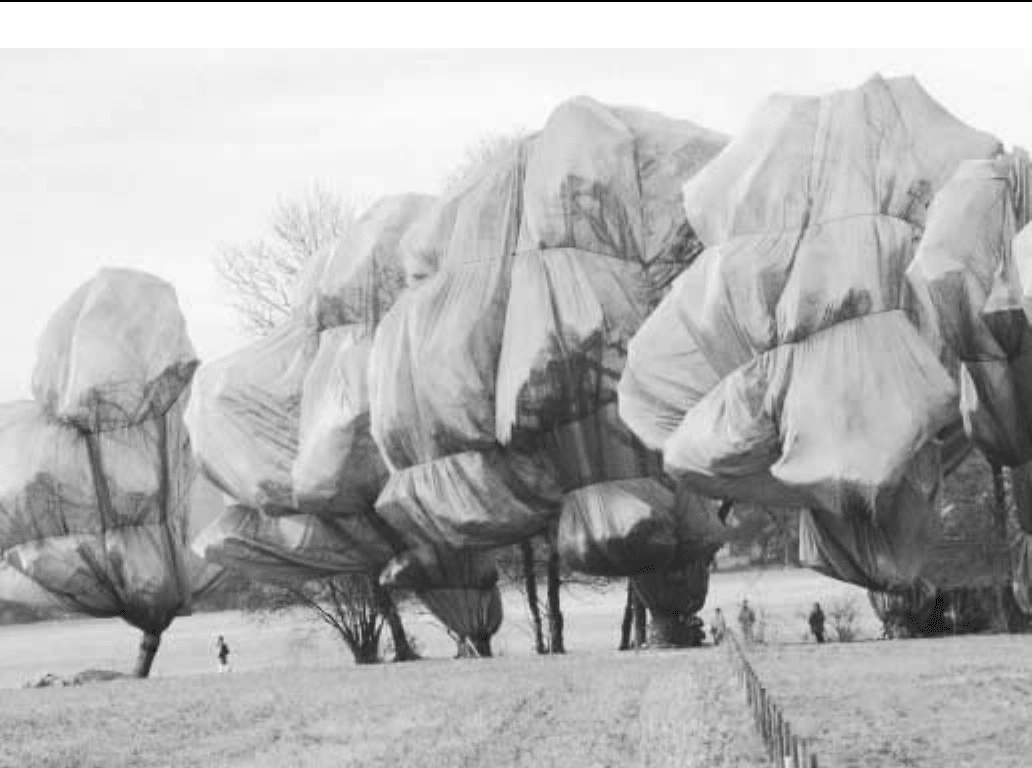
CHRISTO ENCYCLOPEDIA OF POPULAR CULTURE
506
The ‘‘Wrapped Trees’’ project by Christo and his wife Jeanne-Claude in the park of the Foundation Beyeler in Riehen, Switzerland, 1998.
rope. The work was the first of his projects in which Christo had to
solve problems connected to government agencies and public institu-
tions. Controversy erupted when nurses on the privately owned land
protested because they thought that hospital money was being divert-
ed and that a recreational beach would be shut down. Actually,
Christo paid for the project himself and allowed for the beach to
remain open.
While teaching in Colorado, Christo became intrigued by the
Rocky Mountain landscape. Valley Curtain (1971-72, Rifle Gap,
Colorado) was composed of two hundred thousand square feet of
nylon hung from a cable between two cliffs. The bright orange nylon
curtain weighed four tons. Organizational, economic, and public
relations problems delayed construction for a time, but these were
exactly the challenges Christo and Jeanne-Claude had become so
adept in solving. To raise the $850,000 needed, the couple created the
Valley Curtain Corporation. As would become customary, Christo’s
drawings, plans, models, and photographs of Valley Curtain were
sold as art objects to raise money for building the massive artwork.
The first curtain was almost instantly ripped to pieces by high winds; a
union boss had told his workers to quit for the day before it was
properly secured. The second curtain was ruined by a sandstorm the
day after it was hung, but not before it was unfurled to the cheers of
media, news crews, and onlookers. A half-hour documentary was
made to register the course of the work’s construction. In all of
Christo’s projects, photography and documentary film are used
extensively to record the activities surrounding what are essentially
temporary structures.
For his next project, Running Fence (1976), Christo raised two
million dollars through the sale of book and film rights and from
works of art associated with the project. Christo obtained the permis-
sion of fifty-nine private ranchers and fifteen government organiza-
tions. Ironically, the strongest opposition came from local artists who
regarded the project as a mere publicity stunt. Christo then became a
passionate lobbyist for his project, appearing at local meetings and
agency hearings. Winding through Marin and Sonoma counties, the
eighteen-foot-high fence traversed twenty-four miles over private
ranches, roads, small towns, and subdivisions on its way to a gentle
descent into the Pacific Ocean. Open-minded viewers found it lyrical-
ly beautiful; indeed, beauty is one of Christo’s unabashed aims.
Surrounded Islands, Biscayne Bay, Greater Miami, Florida,
1980-83 was Christo’s major work of the eighties and involved
floating rafts of shocking pink polypropane entirely enclosing eleven
small islands. It required more than four hundred assistants and $3.5
million to complete. Sensitive to the environment, Christo decided
not to surround three islands because they were home to endangered
manatees, birds, and plants. Even so, Christo and Jeanne-Claude still
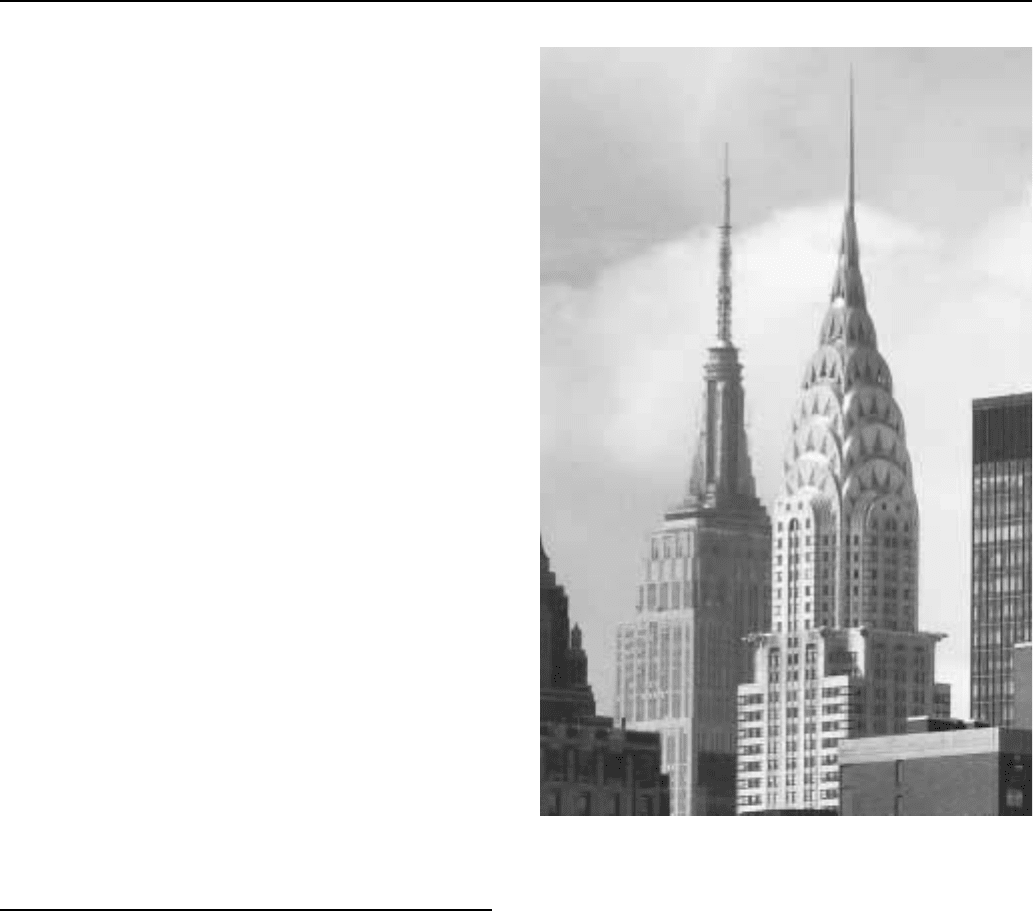
CHRYSLER BUILDINGENCYCLOPEDIA OF POPULAR CULTURE
507
had to contend with lawsuits, lawyers, and public groups. Though
Surrounded Islands extended for eleven miles and traversed a major
city, it was strikingly lovely. Like Running Fence, Surrounding
Islands existed for only two weeks.
Christo staged The Umbrellas, Japan—U.S.A. 1984-91 simulta-
neously in the landscapes north of Tokyo and of Los Angeles.
Roughly fifteen hundred specially designed umbrellas (yellow ones
in California, blue ones in Japan) dotted the respective countrysides
over areas of several miles. Only twenty-six landowners had to be
won over in California; in Japan, where land is even more precious,
the number was 459. The umbrellas were nearly twenty feet high and
weighed over five hundred pounds each. Having cost the artist $26
million to produce, the umbrellas stood for only three weeks begin-
ning on October 9, 1991. Christo ended the project after a woman in
California was killed when high winds uprooted an umbrella. Dur-
ing the dismantling of the umbrellas in Japan, a crane operator
was electrocuted.
Altogether, Christo’s art involves manipulating public social
systems. As the artist has said, ‘‘We live in an essentially economic,
social, and political world.... I think that any art that is less political,
less economical, less social today, is simply less contemporary.’’
—Mark B. Pohlad
F
URTHER READING:
Baal-Teshuva, Jacob. Christo and Jeanne-Claude. Cologne, Benedikt
Taschen, 1995.
Christo: The Reichstag and Urban Projects. Munich, Prestel, 1993.
Laporte, Dominique G. Christo. Translated from the French by Abby
Pollak. New York, Pantheon Books, 1986.
Spies, Werner. Introduction to Christo, Surrounded Islands, Biscayne
Bay, Greater Miami, Florida, 1980-83, by Christo. New York,
Abrams, 1985.
Vaizey, Marina. Christo. New York, Rizzoli, 1990.
Chrysler Building
A monument to the glitzy Jazz Age of the 1920s, the Chrysler
Building in New York City is America’s most prominent example of
Art Deco architecture and the epitome of the urban corporate head-
quarters. This unabashedly theatrical building, which was briefly the
world’s tallest after its completion in 1930, makes an entirely differ-
ent statement than its nearby competitor, the Empire State Building.
The Chrysler Building’s appeal was summarized by architectural
critic Paul Goldberger, who wrote, ‘‘There, in one building, is all of
New York’s height and fantasy in a single gesture.’’
The Chrysler Building was originally designed for real estate
speculator William H. Reynolds by architect William Van Alen. In
1928, Walter Percy Chrysler, head of the Chrysler Motor Corpora-
tion, purchased the site on the corner of Lexington Avenue and 42nd
Street in midtown Manhattan, as well as Van Alen’s plans. But those
plans were changed as the design began to reflect Chrysler’s dynamic
personality. The project soon became caught up in the obsessive quest
for height that swept through the city’s commercial architecture in the
1920s and 1930s. Buildings rose taller and taller as owners sought
both to maximize office space as well as to increase consumer
visibility. Van Alen’s initial design projected a 925-foot building with
The Chrysler Building (foreground)
a rounded, Byzantine or Moorish top. At the same time, however, Van
Alen’s former partner, H. Craig Severance, was building the 927-foot
Bank of the Manhattan Company on Wall Street. Not to be outdone,
Van Alen revised his plans, with Chrysler’s blessing, to include a new
tapering top that culminated in a spire, bringing the total height to
1,046 feet and establishing the Chrysler Building as the world’s
tallest. The plans were kept secret, and near the end of construction
the spire was clandestinely assembled inside the building, then
hoisted to the top. The entire episode defined the extent to which the
competition for height dominated architectural design at the time. The
Chrysler Building’s reign was brief, however; even before it was
finished, construction had begun on the Empire State Building, which
would surpass the Chrysler by just over two-hundred feet.
The finished building is a dazzling display of panache and
corporate power. The most famous and notable aspect of the Chrysler
Building is its Art Deco decoration. With its polychromy, zigzag
ornamentation, shining curvilinear surfaces, and evocation of ma-
chines and movement, the Art Deco style—named after the 1925
Exposition Internationale des Arts Decoratifs et Industriels Modernes
in Paris—provided Van Alen with a means to express the exuberance
and vitality of 1920s New York, as well as the unique personality of

CHUCK D ENCYCLOPEDIA OF POPULAR CULTURE
508
the building’s benefactor. The interior of the Chrysler Building
reflects the company’s wealth. In the unique triangular lobby, remi-
niscent of a 1930s movie set, the lavish decorative scheme combines
natural materials like various marbles, onyx, and imported woods
with appropriate machine-age materials like nickel, chrome, and
steel. Outside, a white brick skin accentuated by gray brick trim was
laid over the building’s steel frame in a pattern that emphasized the
building’s verticality. Steel gargoyles in the form of glaring eagles—
representing both America and hood ornaments from Chrysler Com-
pany automobiles—were placed at the corners of the building’s
highest setback. (These gargoyles became famous after a photo of
photographer Margaret Bourke-White standing atop one of them was
widely circulated). The crowning achievement of the building, both
literally and figuratively, is the spire. A series of tapering radial
arches, punctuated by triangular windows, rise to a single point at the
top. The spire’s stainless steel gleams in the sun. The arches at the
spire’s base were based on automobile hubcaps. In fact, the entire
building was planned with an elaborate iconographic program, in-
cluding radiator cap gargoyles at the fourth setback, brick designs
taken from Chrysler automobile hubcaps, and a band of abstracted
autos wrapping around the building. The use of such company-
specific imagery incorporated into the building’s design anticipated
the postmodern architecture of the 1980s.
The Chrysler Building was not the first corporate headquarters
specifically designed to convey a company’s image, but it may have
been the most successful. The unique building was a more effective
advertising tool for the Chrysler Company than any billboard, news-
paper, or magazine ad. The Chrysler Building, with its shining
telescoped top, stood out from the rather sedate Manhattan skyscrap-
ers. While some observers see the building as kitsch or, in the words
of critic Lewis Mumford, ‘‘inane romanticism,’’ most appreciate its
vitality. Now one of the world’s favorite buildings, the Chrysler
Building has become an American icon, symbolizing the pre-Depres-
sion glamour and the exuberant optimism of the Jazz Age.
—Dale Allen Gyure
F
URTHER READING:
The Chrysler Building. New York, Chrysler Tower Corporation, 1930.
Douglas, George H. Skyscrapers: A Social History of the Very Tall
Building in America. Jefferson, North Carolina, McFarland &
Company, 1996.
Goldberger, Paul. The Skyscraper. New York, Alfred A. Knopf, 1992.
Reynolds, Donald Martin. The Architecture of New York City. New
York, Macmillan Publishing Company, 1984.
Chuck D (1960—)
The primary rapper in one of the most significant hip-hop groups
in the genre’s history, Chuck D founded the New York City-based
Public Enemy in order to use hip-hop music as an outlet to dissemi-
nate his pro-Black revolutionary messages. Because of the millions of
albums Public Enemy sold and the way the group changed the
landscape of hip-hop and popular music during the late-1980s, Public
Enemy’s influence on popular music specifically, and American
culture in general, is incalculable.
Chuck D (born Carlton Ridenhour August 1, 1960) formed
Public Enemy in 1982 with fellow Long Island friends Hank Shocklee
and Bill Stepheny, both of whom shared Chuck D’s love of politics
and hip-hop music. In 1985, a Public Enemy demo caught the
attention Def Jam label co-founder Rick Rubin, and by 1986 Chuck D
had revamped Public Enemy to include Bill Stepheny as their
publicist, Hank Shocklee as a producer, Flavor Flav as a second MC,
Terminator X as the group’s DJ and Professor Griff as the head of
Public Enemy’s crew of onstage dancers. Public Enemy burst upon
the scene in 1987 with their debut album Yo! Bum Rush the Show, and
soon turned the hip-hop world on its head at a time when hip-hop
music was radically changing American popular music. Chuck D’s
early vision to make Public Enemy a hotbed of extreme dissonant
musical productions and revolutionary politics came into fruition
with the release of 1988’s It Takes a Nation of Millions to Hold Us
Back. Recognized by critics at Rolling Stone, SPIN, The Source and
the Village Voice as one of most significant works of popular music of
the twentieth century, It Takes a Nation. . . took music to new
extremes. That album combined furiously fast rhythms, cacophonous
collages of shrieks and sirens, and Chuck D’s booming baritone
delivery that took White America to task for the sins of racism
and imperialism.
Chuck D once remarked that hip-hop music was Black Ameri-
ca’s CNN, in that hip-hop was the only forum in which a Black point
of view could be heard without being filtered or censored. As the
leader of Public Enemy, a group that sold millions of albums
(many to White suburban teens) Chuck D was one of the only
oppositional voices heard on a widespread scale during the politically
conservative 1980s.
Public Enemy’s commercial and creative high point came during
the late 1980s and early 1990s. The group recorded their song ‘‘Fight
the Power’’ for Spike Lee’s widely acclaimed and successful 1989
film Do the Right Thing, increasing Public Enemy’s visibility even
more. After the much-publicized inner group turmoil that resulted
from anti-Semitic remarks publicly made by a group member, Chuck
D kicked that member out, reorganized the group and went to work on
the biggest selling album of Public Enemy’s career, Fear of a
Black Planet.
By then, Chuck D had perfected the ‘‘Public Enemy concept’’ to
a finely-tuned art. He used Public Enemy’s pro-Black messages to
rally and organize African Americans, the group’s aggressive and
propulsive sonic attack to capture the attention of young White
America, and their high visibility to edge Chuck D’s viewpoints into
mainstream discourse. Throughout the 1990s, Chuck D appeared on
numerous talk shows and other widely broadcast events.
Taking advantage of his notoriety, Chuck D often lectured at
college campuses during the late 1980s and throughout the 1990s. He
became a political election correspondent for music video network
MTV and, in 1997, he published a book on race and politics in
America titled Fight the Power.
In a musical genre driven by novelty and innovation, Public
Enemy’s—and Chuck D’s—influence and commercial success began
to wane by the mid-1990s. In 1996 he released the commercially
unsuccessful solo album, Autobiography of Mista Chuck. But unlike
many artists who change their formula when sales decline, Chuck D
